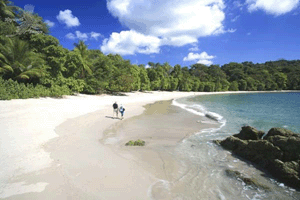
Just a few miles south of Quepos is one of the top beaches in the world, Manual Antonio
Quepos is known for, a place where the rainforest meets the sea, and is on a tropical inlet about halfway down Costa Rica's Pacific coast on the Puntarenas Province. The town gets its name from the Quepo Indian tribe, a subgroup of the Borucas, who inhabited the area at the time of the conquest. As a result of diseases brought by Europeans, warfare and other Indian groups, and slavery, there are no pure blooded Quepos left by the end of the 19th century.
Quepos first came to prominence as a banana exporting port. Due to disease, African palm oil replaced bananas as the local major crop and, because the finished produced is much less bulky than bananas, Quepos declined as a major shipping port. Even as late as the 1950s regular communication with the rest of the country not easy. Roads were almost non-existent. There was a small railroad between Quepos and Parrita and at low tide the Alpa Airline landed a small plane on the beach in front of Main Street.
Tourists (almost all Costa Ricans) came principally in Jan., Feb., and Mar. By the 1960s a group of Gringos mostly hippies, some draft dodgers, sport fishing captains (like Bill Gannon who helped spearhead Costa Rica's catch and release program) and surfers started to build homes and began businesses at Manuel Antonio. And by late 1980, a Sansa Airlines DC-3 began service to the area.
The tourist industry at the time consisted of a gringo bar, El Barba Roja, a few luxury villas at La Mariposa, some rustic cabañas, a beachfront bar called the May y Sombra and that was about it.
By the mid 1980s Quepos became the travel talk and more and more Americans started to settle their. I remember when first entering the town back in 1982 it looked like a Clint Eastwood cowboy movie with its old Western style buildings and dirt roads. And with the awesome beach of Manual Antonio a few miles south the tourist industry started to take off.

Getting in and out of Quepos can be a little scary, this is the bridge one has to cross, but the new road being put in should change this. View video link to get more of an eye full
Quepos/Manual Antonio has become a quite of mix of adventures from around the world, as well as an intrepid group of locals who have hung around for the "Pura Vida."
It is probably the most Americanize town of all of Costa Rica. Manuel Antonio has become extremely popular for the Costa Rica gay community and tourist. A lot of gays have settled there.
Video of the crossing of Quepos and Crossing Costa Rica's Suspension Bridges
Within its city one can find just about everything, clothing and book stores, gyms, ecology groups, yoga and pilates classes, all types of recreation and restaurants, rehab and learning centers and a lot of American features. It is also known for its sportsfishing with a new marina that might put Los Suenos Marina to shame.
A good place to get local info is Quepolandia.
I love Quepos, even if it has gotten to be more touristy. A very cool, kick back, old/modern world town with a lot of culture, nature and recreation – a place that I continue to go back to. In my book it is just one of the best towns in all of Costa Rica. I just hope it does not get ruined by Costa Rica developers.





Quepos is a nice place to visit a couple of times a year for the Saturday vegetable market, but San Isidro has always seemed more exciting to me. Quepos just got a Wal/Mart, so that might give me more reason to visit. I think I’m just getting too old for the congestion in Quepos and Antonio.